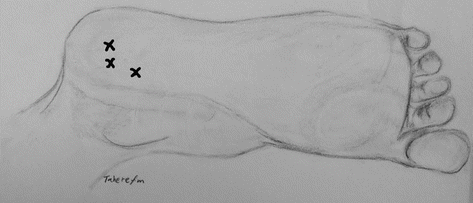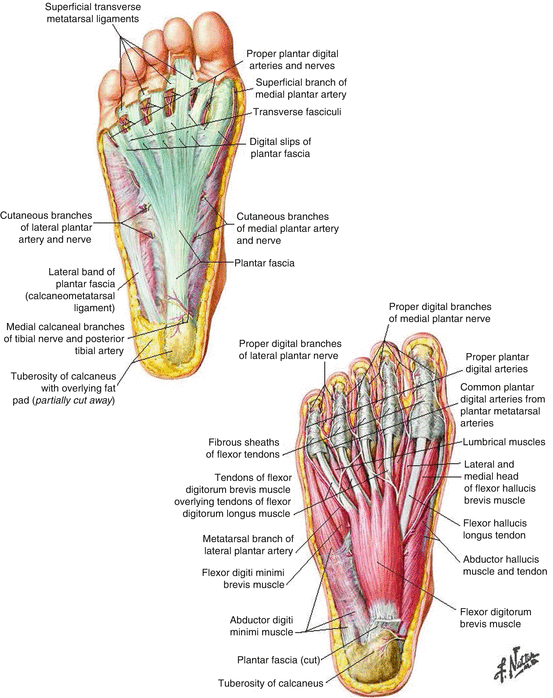(1)
Botulinum Toxin Treatment Program, Yale School of Medicine, New Haven, CT, USA
Abstract
Plantar fasciitis/fasciopathy (PF) is a common problem which affects two million people in the USA and 10 % of runners. The symptoms of heel pain and foot discomfort can interfere with daily functions and are often disabling in the chronic form of PF. Commonly used treatments for symptoms of plantar fasciitis include stretching, taping, night splints, orthosis, nonsteroidal anti-inflammatory medications, iontophoresis, steroid injections, ultrasound extracorporeal and intracorporeal shock waves, acupuncture, and cryosurgery. With most of these approaches, improvement is short lived, and some approaches (i.e., shock wave therapy) are very painful and often require prior nerve block. Furthermore, injection of steroids can cause rupture of the plantar fascia. Clearly, an effective and safe therapeutic approach without substantial side effect is very much needed for PF. Local injection of botulinum toxin A is a relatively novel treatment for PF. The results of two double-blind, placebo-controlled studies have supported its efficacy (level B). A comparator-blinded study has shown that BoNT-A is more effective than betamethasone in relieving pain and improving function at 6 months. Furthermore, the positive effect of ona- and abobotulinumtoxinA lasted often beyond 6 months, and the injections caused no side effects. In this chapter, various therapeutic approaches for management of PF are presented with emphasis on botulinum toxins and their advantages.
Electronic supplementary material
The online version of this chapter (10.1007/978-1-4939-2501-8_6) contains supplementary material, which is available to authorized users.
Keywords
Plantar fasciitisPlantar fasciopathyHeal painBotulinum toxinBotulinum neurotoxinOnabotulinumtoxinAAbobotulinumtoxinAIntroduction
Plantar fasciitis (PF), also referred to as plantar fasciopathy, is a clinical condition caused by degeneration, inflammation, and micro-tears of foot’s plantar fascia; plantar fasciitis is a major cause of heal pain. It is a common ailment among individuals whose work involves substantial foot activity (Thomas et al. 2010). Approximately 10 % of runners have symptoms of PF (Chandler and Kibler 1993). In the USA, PF affects two million people and accounts for a million visits to physicians’ offices annually (Berbrayer and Fredericson 2014). Many patients, however, improve spontaneously after months of discomfort. PF may progress into a chronic form with refractory pain, challenging management in 10 % of the patients (Janister et al. 2014).
Two recent publications (Tahririan et al. 2012; Berbrayer and Fredericson 2014) have updated the clinical spectrum of and treatment options for plantar fasciitis. The pain usually affects the medial side of the heel at the insertion area of plantar fascia (Fig. 6.1). Some patients may experience pain at the middle of the foot (middle of the central band of the fascia), while in others, the pain may spread to the entire foot including the toes. The pain is most noticeable during the initial steps of walking or running. The pain is enhanced by long periods of inactivity preceding activity; weight bearing also worsens the pain. In the chronic form (lasting beyond 6 months), calcaneal pain may be experienced at rest and prevent sleep. One third of the patients complain of bilateral pain. On examination, the foot looks normal, and no weakness is detectable, but approximately 80 % of the patients experience associated tightness of the Achilles tendon (Singh et al. 1997). In some patients, the skin over the medial calcaneal tuberosity is tender, and this tenderness is exaggerated on dorsiflexion of the toes or when standing on tiptoe (Young et al. 2001).


Fig. 6.1
The usual location of pain in plantar fasciitis (Created by Tahereh Mousari; Published with kind permission of © Bahman Jabbari 2014. All Rights Reserved)
Anatomy of Plantar Fascia
In a recent communication, (Stecco et al. 2013) described the anatomy of plantar fascia and its relationship to the Achilles tendon and adjacent muscles in detail. The authors studied anatomy of the foot in 11 cadavers (mean age 72; 6 males and 5 females). Serial transversal sections were obtained every 2 cm from the cutis to the interosseous muscles in order to microscopically examine the relationships between the PF, skin, and muscles. Beneath the skin and the underlying fat pad of the foot, PF appears as a glistening, pearl-colored structure extending from the calcaneus to the metatarsophalangeal (MP) joints. The length of PF is approximately 12 cm from the medial tuberculum to the MP joint. The thickness of PF diminishes significantly as it extends toward the MP joints. At 2 cm from the insertion of the calcaneus, PF is 3.15 mm thick at its center and 1.56 mm laterally. At 10 cm from the insertion point, PF’s thickness is 1.41 mm at its center and 0.66 mm laterally.
Most PF fibers are arranged longitudinally, but some fibers are oblique, and a few are transverse; the fibers close to the proximal and distal insertions may have transverse arrangement. PF is arranged into three longitudinal fiber groups: medial, central, and lateral (Fig. 6.2). At the heel, PF fibers are attached to the medial part of the calcaneum (medial tuberculum), cover the heel as a thin layer, and continue into the Achilles tendon. Beneath PF are the deep fascias of the foot which embed three major foot muscles, the flexor hallucis, the flexor digitorum brevis, and the flexor digiti minimi. Septa from PF penetrate the deep fascia and connect at different points with all three muscles. Close to the metacarpophalangeal joints, PF divides into five segments each attaching to a metacarpophalangeal joint. The fibers of PF are rich in collagen type 1 but also contain hyaluronan which helps PF fibers to easily glide and work like a shock absorber. Plantar fascia is innervated by the terminal branches of the tibial nerve and medial calcaneal and medial and lateral tibial nerves. Plantar fascia is well innervated specially in its medial and lateral parts; it contains an abundance of Pacinian and Ruffinian corpuscles suggesting a role for it in the sole’s proprioception (Stecco et al. 2013).


Fig. 6.2
Anatomy of the plantar fascia and the subfascial muscles (From Netter collection. Netter illustration used with permission of Elsevier, Inc. All rights reserved. www.netterimages.com)
Pathophysiology of Plantar Fasciitis
The plantar fascia serves both astatic and a dynamic purpose. The static function deals with weight bearing; it supports the arch of the foot. The fascia contracts and elongates during walking allowing the medial arch to flatten and elevate—the so-called wind glass phenomenon (dynamic phase).
Despite the fact that PF is a clinically well recognized, the details of its pathophysiology remain elusive. Most recent data indicate the pathological changes are more in the form of degeneration (fasciopathy) rather than inflammation (fasciitis) of the fascia, although some elements of the latter are also present. Repetitive trauma to the fascia invariably is a major contributing factor to PF; PF is also more common among overweight individuals. Heel spurs are also common in association with plantar fasciitis suggesting a relation to PF’s pathophysiology.
The role of triceps surae muscles in the pathophysiology of PF is increasingly recognized. Contraction of plantar flexor muscles and loss of flexibility of these muscles are proposed as risk factors for the development of plantar fasciitis (Cheung et al. 2006; Kibler et al. 1991). This view is supported by a recent detailed anatomopathological evaluation of PF which demonstrated a high correlation between Achilles tendonitis and PF. Radiologically, a PF thickness of 4 mm or more correlates with clinically active PF. In the study of Stecco et al. (2014), 5 of 27 patients with Achilles tendonitis had a PF thickness of 4.5 mm or more versus none of those in whom radiological data did not support the presence of Achilles tendonitis and PF.
Treatment of Plantar Fasciitis
Recently, Berbrayer and Fredericson (2014) reviewed the literature on current treatment of plantar fasciopathy/fasciitis and provided an evidence-based account of efficacy of several therapeutic approaches. Depending on the quality of the studies, the level of efficacy was simply rated as low, medium, or high. Treatment modalities for acute (less than 3 months duration), subacute (3–6 months duration), and chronic (>6 months duration) were described individually.
In this section, the information on treatment of plantar fasciopathy/fasciitis, for the most part, is derived from Berbyer and Fredericson’s review. Following this section, a review of the literature on BoNT treatment of plantar fasciitis will be provided using the level of evidence and efficacy (A, B, C, U) according to the guidelines of the American Academy of Neurology (Appendices 3.1 and 3.2).
Acute Phase
The recommended treatment in this stage consists of stretching exercises, foot orthosis, soft tissue trigger point manual therapy, calcaneal taping, iontophoresis, and treatment with nonsteroidal anti-inflammatory agents (NSAID).
Stretching Exercises
Three randomized trials are available with different types of stretching exercises employed in the studies: Achilles stretching and stretching of planter fascia that can be performed with either weight bearing or non-weight bearing and intermittent versus sustained. Stretching is usually performed several times daily and provides 2–4 months relief in the acute phase. The review concluded that stretching is effective in reducing pain and improving function in the acute phase.
Foot Orthosis
Foot orthosis is commonly used in patients with PF. Both over-the-counter and customized orthotics can be used. In a multicenter study of 236 patients, foot orthosis (prefabricated) plus stretching was found to be superior to stretching alone (P = 0.022) (Pfeffer et al. 1999). Foot orthosis can be used in all stages of PF.
Soft Tissue Trigger Point Manual Therapy
Retrospective studies suggest temporary reduction of pain in the acute phase using soft tissue trigger point manual therapy.
Iontophoresis
Two double-blind, placebo-controlled studies are available. In the first study of 40 ft from 31 patients, dexamethasone iontophoresis was found superior to placebo and relieved pain for 2 weeks; no long-term benefits were noted, however (Gudeman et al. 1997). In the second study (Osborne and Alison 2006), 43 feet from 31 subjects were studied in three groups: iontophoresis (1) with 0.5 % acetic acid, (2) with 4 % dexamethasone, and (3) with placebo. The investigators found acetic acid to be more effective than steroid iontophoresis and relieved pain for 2–4 weeks.
Nonsteroidal, Anti-inflammatory Agents
Only one double-blind, placebo-controlled study is available pertaining to the use of NSAIDs in PF. Donely et al. (2007) studied 29 patients with PF. All patients were using a heal cord stretcher and night splints. NSAID was added to their ongoing treatment. Modest improvement of pain was noted by adding NSAID to the ongoing treatment (low level).
Subacute Stage
Steroid therapy and acupuncture are both considered options for this stage. Placebo-controlled studies are scarce. Mc Millan et al. (2012) showed the efficacy of ultrasound-guided dexamethasone over placebo at 4 weeks after treatment (P = 0.03). Several open studies also showed a short-term pain relief from prednisone in PF. A major issue with steroid therapy is rupture of the plantar fascia that occurs in 10 % of the patients following injection.
Acupuncture
Zhang et al. (2011) studied two groups of subjects (28 in each) blindly with two different techniques of acupuncture (one used as control). One group received acupuncture in acupoint pc7 a location known to affect heel pain. For the group, acupoint Hegu that has some pain properties was used. The primary outcome was perception of significantly lower heal pain at 1 month post acupuncture. A second study (Karagounis et al. 2011) compared acupuncture with NSAID treatment, and primary outcomes were measured at 1 and 2 months. Neither study met their primary end point, but both showed considerably more reduction of pain in the acupuncture group.

Full access? Get Clinical Tree








